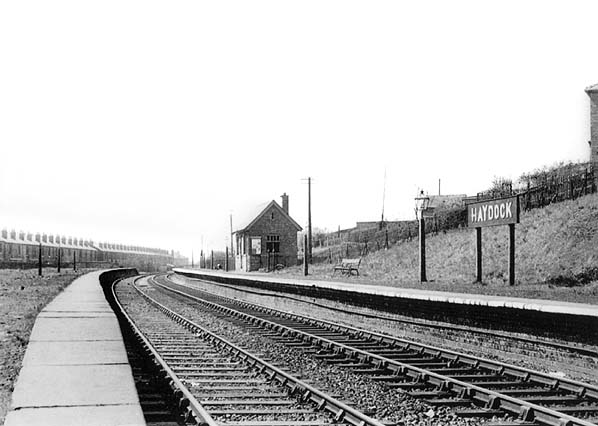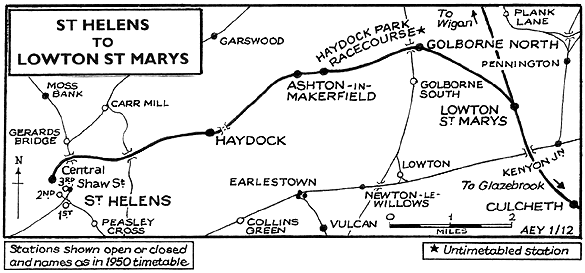|
Notes: Haydock station was situated on Lowton St Marys – St Helens branch of the Great Central Railway (GCR). At Lowton St Marys the branch connected to the GCR Glazebrook and Wigan line which at its southern end linked to the Cheshire Lines Committee (CLC) Liverpool and Manchester main line.
The GCR St Helens branch had originally been promoted as an ambitious scheme to link the Glazebrook and Wigan line to Liverpool via a connection with the CLC at Fazakerley. The line was promoted by the St Helens & Wigan Junction Railway (SH&WJR) who obtained an Act to build it in July 1885. The company had great difficulty in raising finance and the first sod was not cut until 28 January 1888. On 26 July 1889 the SH&WJR was renamed the Liverpool, St Helens & South Lancashire Railway (LSH&SLR) and the line between Lowton St Marys and St Helens opened to goods services on 1 January 1895.
Haydock station opened when passenger services were introduced to the line on 3 January 1900. It was located on the south side of Clipsley Lane (A559) which passed over the line on a bridge just to east of the station.
 The booking hall and office was located on the south side of Clipsley Lane to the east of the bridge. It was a single-storey brick building with a slate roof. From the rear of the building a footpath ran directly west at a falling gradient to the down platform (St Helens direction). The platform was constructed with a brick face backfilled with cinders, and a simple brick waiting room was provided. The up platform was constructed in the same way and also had a waiting room built in the same style as that on the down platform. The up platform was connected to Clipsley Lane by a sloping footpath. The booking hall and office was located on the south side of Clipsley Lane to the east of the bridge. It was a single-storey brick building with a slate roof. From the rear of the building a footpath ran directly west at a falling gradient to the down platform (St Helens direction). The platform was constructed with a brick face backfilled with cinders, and a simple brick waiting room was provided. The up platform was constructed in the same way and also had a waiting room built in the same style as that on the down platform. The up platform was connected to Clipsley Lane by a sloping footpath.
Haydock was provided with a goods siding which branched off the main line west of the station and ran behind the down platform.
At the time of opening the passenger services at Haydock were provided by the Great Central Railway (GCR) who had been a supporter of the LSH&SLR. There were six trains in each direction from Haydock. All of the westbound services went to St Helens Central, five of the eastbound trains went to Manchester Central and one to Lowton St Marys.
Passing directly in front of the station entrance was a tramway of the St Helens & District Tramway Company Ltd. The tramway had opened from St Helens to Haydock in 1882 and by the time that Haydock station opened it was worked by steam tramway locomotives. The Haydock terminus of the tramway was on Clipsey Lane only 50yd east of the railway station. The tramway was a competitor for St Helens passengers. On 4 April 1903 the South Lancashire Tramway company made an end-on connection with the St Helens & District at Haydock. This created a line between St Helens and Bolton via Ashton-in-Makerfield. Ashton-in-Makersfield was the next station east of Haydock and the tramway ran right past it main entrance. Electric trams were introduced at the same time, speeding up journeys, which had an even greater impact on Haydock station.
The GCR absorbed the LSH&SLR company in 1906.
The Haydock area had a number of collieries and the coal traffic generated by them was lucrative to the GCR justifying its taking over the line. Passenger traffic, however, never lived up to expectations. For local journeys Haydock station faced direct competition from trams of the St Helens Corporation which passed right by the entrance.
In the July 1922 timetable there were five up and six down services Monday-to-Saturday. There was no Sunday service.
 On 1 January 1923 the Lowton St Marys – St Helens line became part of the London & North Eastern Railway (LNER). The line was double-track from Lowton St Marys to a point just short of St Helens where it became a single track. During the LNER period the line was singled from St Helens to Haydock. The up line through Haydock station became bi-directional and the down line platform was taken out of use. Its signs were removed and the waiting room was demolished and the up platform then served trains running in both directions. It retained its waiting room and signage. On 1 January 1923 the Lowton St Marys – St Helens line became part of the London & North Eastern Railway (LNER). The line was double-track from Lowton St Marys to a point just short of St Helens where it became a single track. During the LNER period the line was singled from St Helens to Haydock. The up line through Haydock station became bi-directional and the down line platform was taken out of use. Its signs were removed and the waiting room was demolished and the up platform then served trains running in both directions. It retained its waiting room and signage.
The down line was left in situ at the station and was used as a long siding.
Trams ceased to run on the Haydock line on 3 August 1930. They were replaced with trolleybuses so there was no gain for the railway.
The goods facilities at Haydock station closed on 3 March 1952.
The LNER summer timetable for 1947 showed only four up and four down services on Monday-to-Friday as seen in the table below. On Saturday there was one less down service. No trains ran on Sunday.
Up Trains Summer 1948 |
Destination |
Down Trains Summer 1948 |
Destination |
7.12am |
Manchester Central (Glazebrook on Saturdays) |
8.57am |
St Helens Central |
9.42am |
Manchester Central |
1.32pm |
St Helens Central |
2.02pm |
Manchester Central |
4.35pm |
St Helens Central |
4.59pm |
Manchester Central |
6.17pm (Saturdays Excepted) |
St Helens Central |
At Nationalisation on 1 January 1948 it became part of British Railways Eastern Region but, being remote from that region, it was announced on 30 November 1948 that the line would be transferred to the London Midland Region. The summer 1949 timetable showed a similar level of service as that provided by the LNER in their last year.
With such a poor level of service it was not surprising that British Railways withdrew it from 3 March 1952 and Haydock station was closed completely.
The line through Haydock continued to be used by freight trains until it closed completely between a point half-a-mile east of Haydock station and St Helens on 4 January 1965. The track was lifted shortly after closure and in the 1970s the station site was developed as a residential area.
Ticket from the last train from St. Helens to Haydock from Stan Anderton
Click on the station name for other stations
on the
St. Helens Central - Lowton St. Mary's Line. St.
Helens Central,
Ashton-in-Makerfield, Haydock Park Racecourse,
Golborne North & Lowton St.
Mary's |







 Home Page
Home Page 
 The booking hall and office was located on the south side of Clipsley Lane to the east of the bridge. It was a single-storey brick building with a slate roof. From the rear of the building a footpath ran directly west at a falling gradient to the down platform (St Helens direction). The platform was constructed with a brick face backfilled with cinders, and a simple brick waiting room was provided. The up platform was constructed in the same way and also had a waiting room built in the same style as that on the down platform. The up platform was connected to Clipsley Lane by a sloping footpath.
The booking hall and office was located on the south side of Clipsley Lane to the east of the bridge. It was a single-storey brick building with a slate roof. From the rear of the building a footpath ran directly west at a falling gradient to the down platform (St Helens direction). The platform was constructed with a brick face backfilled with cinders, and a simple brick waiting room was provided. The up platform was constructed in the same way and also had a waiting room built in the same style as that on the down platform. The up platform was connected to Clipsley Lane by a sloping footpath.  On 1 January 1923 the Lowton St Marys – St Helens line became part of the London & North Eastern Railway (LNER). The line was double-track from Lowton St Marys to a point just short of St Helens where it became a single track. During the LNER period the line was singled from St Helens to Haydock. The up line through Haydock station became bi-directional and the down line platform was taken out of use. Its signs were removed and the waiting room was demolished and the up platform then served trains running in both directions. It retained its waiting room and signage.
On 1 January 1923 the Lowton St Marys – St Helens line became part of the London & North Eastern Railway (LNER). The line was double-track from Lowton St Marys to a point just short of St Helens where it became a single track. During the LNER period the line was singled from St Helens to Haydock. The up line through Haydock station became bi-directional and the down line platform was taken out of use. Its signs were removed and the waiting room was demolished and the up platform then served trains running in both directions. It retained its waiting room and signage. 